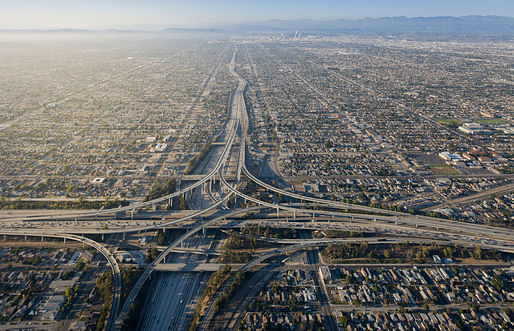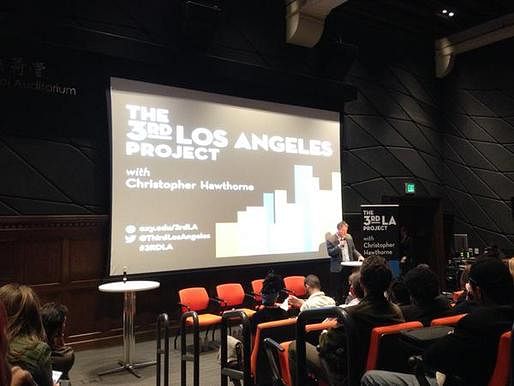
If you conceive of Los Angeles as having three distinct historical periods – as Christopher Hawthorne, architecture critic for the L.A. Times and the driving force behind The Third L.A. series, does – then the first period encapsulated the 1880s to the 1940s, the second the 1940s to the new millennium, and the third from 2000 to now. It is this current period which The Third L.A. series situates itself. It's also the era which fascinates Hawthorne: specifically, his series investigates how the city's denizens are conceiving of and working toward creating an altogether more integrated, metropolitan-oriented Los Angeles. In partnership with southern California public radio station KPCC and Occidental College, Hawthorne assembled Los Angeles Deputy Mayor Rick Cole, Occidental Art History Professor Amy Lyford, and fellow L.A. Times book critic David Ulin to discuss the influence on city politics and culture of Mike Davis' frothy, passionate, anti-booster classic City of Quartz, a book which is quietly celebrating the 25th anniversary of its publication.

Instead of being a melange of wandering panel-speak, the third installment of The Third L.A. series, which took place last Wednesday evening at Occidental (where Hawthorne also teaches), was an elegantly hewn framework adorned with both scripted and spontaneous verbal delights. Hawthorne began by reading the initial reviews of City of Quartz from LA’s second period, including his own and the New York Times' entitled "If This is Hell, Why Is it So Popular?" The reviews provided context for the mindset of LA’s previous era; namely, the dark complexities of Los Angeles Davis profiled were hardly conventional fare, and struck many as absurd or draconian after decades of sunny boosterism. Hawthorne then read written reactions to Davis' work from two long-time Angelenos: David Kipen, the founder of the Libros Schmibros lending library, wrote that City of Quartz had served as a kind of "self-averting prophecy," and OC Weekly Editor Gustavo Arellano, called the book "a manual for a generation of city leaders."
Although Hawthorne explained that Mike Davis would not appear in person as the evening would undoubtedly take the character of either "a roast or a funeral," Davis did answer several of Hawthorne's questions about the book via email. These written questions and responses were briefly read aloud by Hawthorne's students at two podiums, an ingenious presentation technique which allowed the audience to concentrate on the content of the discussion, rather than the personalities involved.

The evening then rapidly segued into the panel discussion with Hawthorne, Amy Lyford, Rick Cole, and David Ulin. Amy Lyford kicked things off with a survey of Los Angeles’ political and cultural climate in the late 1980s and 1990s, citing Arata Isozaki's Museum of Contemporary Art on Grand Avenue as the perfect physical embodiment of Davis' central thesis of L.A. – a city of fortified globalization and economic disenfranchisement. After a discussion of the past, each panelist described their vision of contemporary Los Angeles. The wonderfully self-effacing Rick Cole explained that "we take selfies, not x-rays" when referring to the L.A. media's tendency to avoid deeply researched, historically rigorous stories in favor of surface-y items on the 10 Best Restaurants on the Westside. He also termed Mike Davis' book "a love letter written by someone who was deeply spurned by the city," a description heralded both by Amy Lyford and David Ulin. In a slightly cheerier vein, Ulin went on to say that Los Angeles is not a place that simply offers itself up to you, but rather is a place that you have to "get off your ass and look for." He also described Davis' prose style as a "quintessence of negative capability," a gorgeous phrase with which Hawthorne adjourned the panel discussion and opened up the floor to questions.
The audience proved to be as feisty and memorable as the panel. At Hawthorne's invitation audience member Aaron Paley, founder of CicLAvia, summarized the reaction of native Angelenos to City of Quartz's supposed revelations as: "What took so long?" He ran through a vivid list of museum exhibits, live performances and social outreach programs of 1980s Los Angeles, before asserting that to be alive in those times was "exciting, edgy and heady." One of Hawthorne's students, Matthew Ingle, asked the panel a question about the difference between reurbanization and gentrification, a distinction which poignantly touched on Amy Lyford's descriptions of the roach-infested but integrated communal reality of mid 1990's cafes in downtown. Lyford felt that the chaotic mix of class and personality that permeated Los Angeles in those times has now been largely swept away into displaced pockets as developers gradually carve up and reclassify downtown into swanky condos and refurbished districts.

As a whole, the evening served as a bon mot-infused recollection of a time when the idea of infinite expansion was taken for granted. This is the biggest difference between the Second L.A. and the Third L.A; that in the late 1980s, no one could imagine a future Los Angeles that was not based on untrammeled growth, whereas in our current era, we find unplanned growth to be fanciful and harmful. The panel discussion proved to be an elegant encapsulation both of The Third L.A.'s thesis and a reflection on Davis' seminal work: Angelenos, whether ordinary citizens or city leaders, are no longer in thrall with the expansionist, infinite thinking mindset of boosterism, but rather with the notion of working with and improving what we already have. Thanks to Davis' often over-the-top but sincere examination of 1980s L.A., our current civic mindset is aware of history, and not blindly subservient to airbrushed myth.
So what of Mike Davis, a man who was essentially driven out of L.A. because City of Quartz was both so profoundly reviled and heralded? In a coda, Hawthorne's students took to the stage to read a final question and answer from the author. When asked about the legacy of the book in reference to the mythical Greek figure whose prophetic accuracy was cursed to never be believed, Davis replied: "To show I have a sense of humor, my daughter's name is Cassandra."

4 Comments
Nice write-up, Julia. Sounds like an excellent event to be at.
Phoenix has always been a little behind LA. I know Phoenix is a very different city, but I feel as if it might be in a similar state of " the chaotic mix of class and personality" that LA was previously, while also dealing right now with the closing of boundaries that wealth brings.
Thanks, Donna!
I've been to Phoenix sparingly, but I'm intrigued by your description. How would you (or would you?) describe the mix of industry out there? I think a multi-faceted industrial/creative base is key to opening up otherwise impermeable class boundaries, plus a non-hierarchical concept of space (i.e., cheap digs in relatively close proximity to big economic drivers).
Can anyone who lives in Phoenix now answer this? I visit a few times a year after leaving it 25 years ago.
What I see there now is an enormous resort/entertainment/retail industry that requires high numbers of low-wage workers, with more coming in by the day, both legally and illegally. There is also a constant new influx of wealthy retirees and business people, as well as a large community or old-guard Phoenix scion families. At one time there were expensive bedroom communities to the north of downtown, but those have now been engulfed within the metropolitan area so there are both wealthy and poor pockets, as well as middle class, all adjacent with boundaries of streets or elevation (the mountainside lots are expensive).
My overall sense is that it's growing and changing at breakneck speed, faster than they even know how to manage it, with many individual communities smashed into one another, and I think that is similar to LA in the 80s.
10 Best Panel Discussions in 10 Best Restaurants is the 3rd LA way.
Block this user
Are you sure you want to block this user and hide all related comments throughout the site?
Archinect
This is your first comment on Archinect. Your comment will be visible once approved.